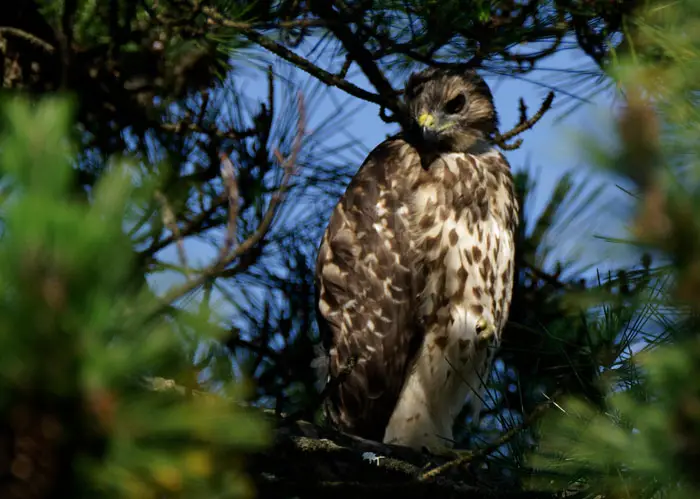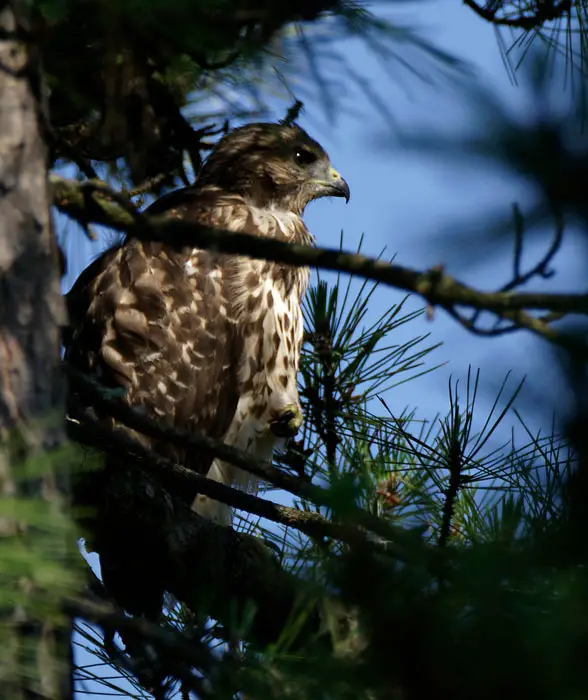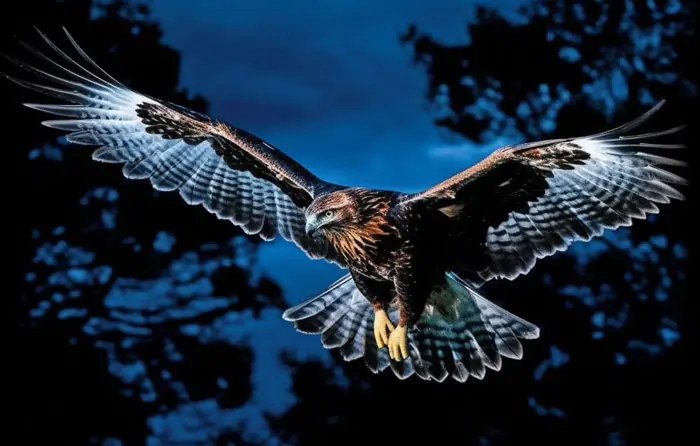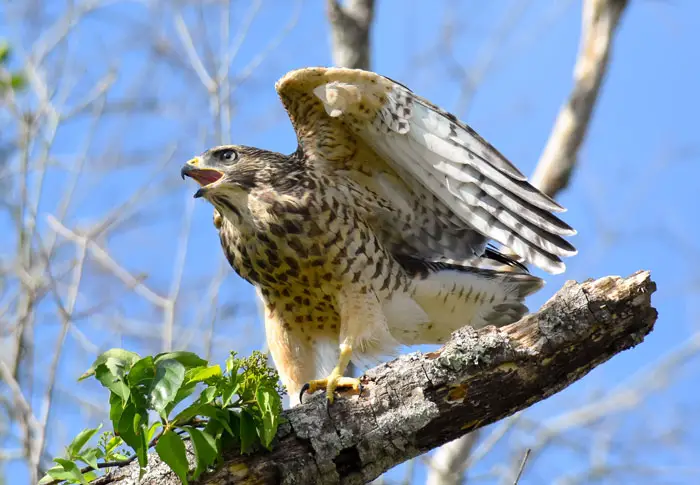The hunting prowess of hawks has a terrific reputation. With their extremely good eyesight and razor-sharp talons, hawks hunt their prey down from a height. You might already have heard someone has hawk eyes, which refers to excellent vision similar to hawks.
This bird of prey falls under the Accipitridae family. The most common species of this family is the red-tailed hawk. They are common in almost every continent in the world except Antarctica. Other species range from North to Central America, Canada to Mexico, South America, Europe, and Asia. Every little detail of their behavior is important for hawk conservation, hunting included.
Though hawks are known to hunt in the daytime, do they hunt at night? No, hawks don’t hunt at night, because they don’t have night vision.
In this article, we will discuss various types of hawks and their hunting habits. You will also learn the environmental factors affecting their hunting behavior. From the nocturnal hunting habits of them to the importance of hawk conservation, everything will be covered here. Let’s get into more details.
Types of Hawks and Their Hunting Habits

The hunting habits of these birds may vary depending on the species. Below is a quick overview of some common hawk species hunting behavior.
- Red-Tailed Hawk: Among so many hawk species, some are prevalent in regions like Central America, Mexico, Canada, Alaska, etc. The most common of them is the red-tailed hawk, which gets its name from its distinctive tail. The tail has a rusty red color, and these birds are usually seen in open country areas.
The most common prey of red-tailed hawks is small rodents. Besides, it can also hunt down squirrels, snakes, insects, frogs, and small birds. They usually choose high perches for hunting and nest in cliff ledges. Like most other species, they don’t hunt at night.
- Sharp-Shinned Hawk: Sharp-shinned hawks fall in the accipiter group, and they are common in North America, Central America, and South America. These birds are agile hunters, and their favorite prey is small birds.
In fact, they are the smallest hawks that eat birds. Besides woodlands, sharp-skinned are found in urban areas and farmlands. Gray-blue wings with rusty speckles are the easiest way to identify these hawks. They also don’t hunt at night or when the visibility is too low.

- Cooper’s Hawk: Another common hawk in the accipiter group is Cooper’s hawk. It has amber eyes with gray wings. The breast may have brown and white speckles. Birds and small rodents are their favorite prey. And the popularity of this species is also increasing in suburban or urban areas. Though these areas are usually illuminated at night, the species won’t hunt at night.
- Rough-legged Hawk: Rough-legged hawks are common in North America, Europe, and Asia. These birds are dark brown with some white spots. But pale colors are also seen. In the summer, the bird migrates to the Arctic Tundra. Like most other species, they don’t hunt at night.
- Red-Shouldered Hawk: Red-shouldered hawks also have a combination of brown and white on their wings. Though the breast area also has a similar combination, the color is usually lighter. Their whistle is similar to a blue jay. These birds are found in coastal regions of California, Baja California, South America, and Northern Mexico. Though hunting at dusk isn’t rare, they usually don’t hunt at night.
- Ferruginous Hawk: Ferruginous hawks are the largest in the Buteo group. They usually have dense feathers on their legs and body. Though the head is gray, the back of the bird has a rusty color pattern. These birds usually live in open terrains, such as prairies or deserts in Colorado, Nevada, Utah, Arizona, and New Mexico. All hunting happens at daylight.
Though they are mistaken as nocturnal predators, they typically hunt in the daytime. Sometimes, they can roam around the roosting area, which is the reason behind this assumption.
Hunting Techniques and Strategies of Hawks
- Hawks use their excellent vision and sharp talons for hunting.
- They usually follow the prey from a high perch or soar around it.
- While diving, they accelerate very quickly and swoop down on the prey out of the blue.
- They hold the prey with their strong talons and use them to break the neck of the prey.
- A wide variety of hunting techniques are prevalent among hawks. Besides high soaring, they use hover and pounce technique. Aerial pursuit is also common.
Environmental Factors Affecting Hawk Hunting Behavior
As diurnal raptors, hawks typically hunt in the daytime. But their hunting or soaring patterns might not be the same in all conditions. Multiple factors, including weather conditions, daylight hours, and prey migration patterns, affect their hunting behavior.

Impact of Weather Conditions
According to research, weather conditions greatly impact soaring. Hawks prefer to soar higher on clear days. But if the sky is cloudy or the relative humidity increases, they fly less than usual. High wind velocity helps them soar higher, so they hunt less when the wind velocity is low.
They can also sense the decrease in atmospheric pressure and fly less in such conditions. Precipitation also impacts the bird-hunting activity of hawks.
Influence of Daylight Hours
You might ask, what time do hawks hunt? As they are diurnal birds, they mostly hunt during the day. But they are sometimes seen hunting at late hours, especially at dusk. As the length of the day is longer in summer, they get enough daylight to hunt. So, they return to their nests early in the afternoon.

But when the daylight hours are shorter in the winter, hawks may face a scarcity of prey. In such cases, they might hunt for long hours until it is completely dark.
Effect of Prey Migration Patterns
Hawks dwelling in urban or suburban areas don’t get affected much due to prey migration patterns. It mostly happens to birds living in the wilderness, who are solely dependent on the prey in their natural habitats.
When prey birds or other animals are in large flocks due to migration, hunting becomes easier for hawks. In other seasons when the bird migration is not frequent, the starving risk increases for hawks.
Behavioral Adaptations of Hawks
With the change in habitat, the hunting behavior of hawks is also affected. The bird population is usually less in urban areas. So, they living in these areas depend on small rodents and insects.
But large rodents and small birds are the favorite prey of these birds in mountainous regions. And this is why avian ecology is an important factor for hawks to adapt to their natural habitats.
Nocturnal Hunting Habits of Hawks
Despite popular beliefs, hawks aren’t nocturnal birds. Here is a detailed discussion of their nocturnal hunting habits. Plus, you will get an answer to a burning question, do hawks hunt at night?

Hawk’s Night Vision Capabilities
As you might already know, hawks have excellent vision in daylight. They have about eight times better eyesight than humans. As a result, they can spot their prey from miles away. They can also see finer details than humans.
But the situation changes at night. Hawks don’t have tapetum lucidum in their eyes. This layer of tissue helps in reflecting more light to the retina to increase visibility in low light conditions. As these birds don’t have it, their eyes can’t absorb enough light to see at night. Despite having lateral and binocular vision, they can’t clearly see at night. So, they avoid flying at night.

Impact of Low Light Conditions
Not having good night vision capabilities is one of the main reasons hawks don’t hunt at night. Another weighted impact on hunting behavior is the absence of their prey in low-light conditions. They mostly depend on rodents, small birds, snakes, insects, etc., for their diet.
But these creatures are usually active during the day. So, hawks adapted to diurnal hunting behavior to make the best use of resources.
Crepuscular Hunting Behavior of Hawks
Though hawks are diurnal, they usually hunt two times. One is in the early morning, and another in the late afternoon. During these periods, the sun is relatively lower. So the temperature is more comfortable for the predator.

Hunting in the late afternoon is more commonly known as crepuscular hunting behavior. The main reason for hunting in these periods is the abundance of their prey.
Most rodents and birds are active during these periods, and hawks take advantage of the situation. So, it is more likely to see a hawk in action early in the morning or just before dusk for readers interested in bird watching.
Impact of Moonlight on Hunting Behavior

Though moonlight can affect some animal behavior, the hunting behavior of hawks doesn’t change in the moonlight. As they can’t see well at night, they prefer to be safe at their nesting sites. Even if there is moonlight, they won’t come out of their roosting areas to keep from predators like owls.
Other predators, such as snakes and raccoons, can steal eggs from hawks’ nests. So, hawks avoid going out of their nest during the night even if there is moonlight.
The Importance of Hawk Conservation
Some hawk species have an Endangered status, while others have a Threatened status. So, thinking about hawk conservation is crucial.

Role of Hawks in Ecosystems
- The main role of hawks in any ecosystem is to check the population of their prey. For example, rodent populations can explode in an ecosystem due to the abundance of food. Hawks or other birds of prey help in balancing the population.
- They also work as an ecological gauge. As these birds are more sensitive to environmental changes than humans, their behavior can work as warnings for threats in the aerial ecosystem.
Need for Conservation Measures to Protect Hawk Species
Besides balancing the prey population in the ecosystem, various species of hawks help farmers save their crops. For example, they eat grasshoppers, field mice, and rabbits. It is a very important method of biological pest control.

As some species, like Queen Charlotte Goshawk, are on the Threatened list, taking necessary conservation measures is important.
Impact of Human Activities on Hawk Populations
One of the key impacts of human activities on hawk populations is the fragmentation of hawks’ habitats by humans. As grasslands or open fields are getting reduced day by day, hawks are being compelled to choose urban areas for building their nests. And finding prey in the crevices of cities is becoming more challenging for hawks.
Ways Individuals Can Contribute to Hawk Conservation Efforts

- Human activity should be confined to non-nesting periods.
- No human activity should be allowed within a 2 km radius around the nesting site of hawks.
- Elevated perches around nesting sites should be protected to conserve hawk species.
FAQs
Find answers to some frequently asked questions about hawks’ hunting behavior.
A: Hawks’ diet can be diverse, but the most common prey of them is small to medium mammals. Mice, ground squirrels, voles, rabbits, small birds, and reptiles are commonly eaten by various hawks.
A: Mammals, aves, and reptiles are the most common prey species hunted by hawks. Among mammals, hawks prefer different species of small to medium rodents. Small birds are also the favorite prey of hawks.
A: As hawks are diurnal predators, they typically hunt during the day. But they are most active early in the morning and in the late afternoon. When rodents and birds return to their nests before dusk, hawks prefer to swoop on them as their last meal of the day.
A: Not necessarily. Different hawk species use different hunting methods. For example, some hawks will use high soaring techniques for hunting. The hover and pounce method is also common for hawks flying over open landscapes. Perch and swoop is another common method where they sit and watch for their prey.
A: If you see hawks soaring high in the sky in a circular path, it is an indication that the bird is watching out for its prey. Hawks silently sitting on high perches and looking down on their prey are also about to hunt.
Conclusion
Contrary to popular belief, hawks don’t hunt at night. This is because their eyesight isn’t suitable for seeing in the dark. So, they are mostly active during the day. We discussed the hunting habits of various types of hawks in different conditions.
A lot of factors, including weather conditions, daylight hours, prey migration patterns, habitats, low light conditions, etc., impact the hawks’ hunting behavior. And learning these factors is necessary for hawk conservation. Understanding bird migration patterns is also important for conserving hawks.
Predatory birds like hawks are important for maintaining a balance in the ecosystem and checking their prey population. Preventing crop damage is another crucial role of these birds in the ecosystem. So, the community should come forward and take the necessary conservation measures to protect hawks.
You should research more about the hunting behavior of hawks to figure out suitable measures for hawk conservation.







